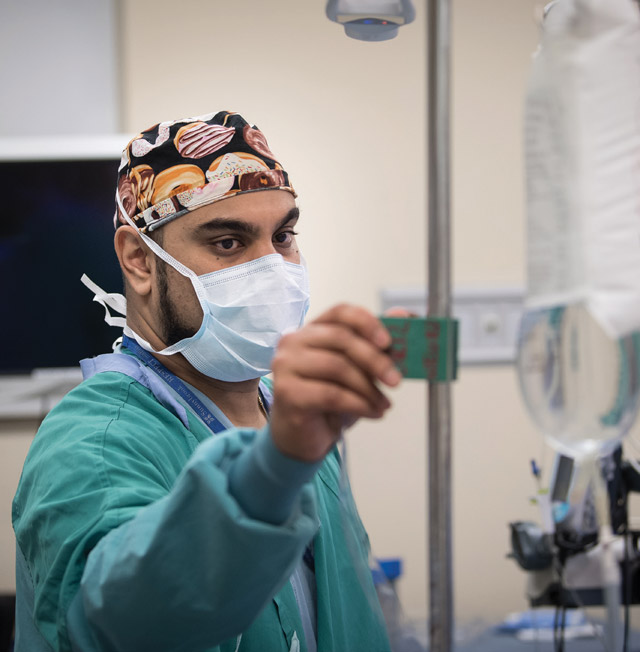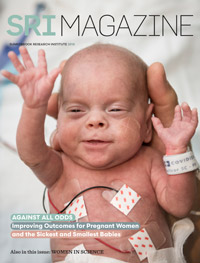Hunting down the solution to postpartum hemorrhage

Trial seeks to uncover whether drug can prevent after-birth bleeding before it begins
September 12, 2018

Dr. Asim Alam is exploring whether tranexamic acid can be used to prevent after-birth hemorrhage.
The interpretation section of an eagerly awaited landmark paper summarizing a trial that investigated treatment for excessive after-birth blood loss noted that tranexamic acid should be given immediately after bleeding onset. Any finding addressing this high-priority area of research is paramount—it’s estimated that 18% of maternal deaths in 2015 were a result of hemorrhage; yet, upon reading the section, Dr. Asim Alam asked, ‘But if all women have some degree of bleeding during delivery, shouldn’t the drug be administered before hemorrhage starts?’ Having already toyed with the idea of using the drug pre-delivery, the obstetric anesthesiologist’s impulse to act was stoked.
Tranexamic acid, otherwise known as TXA, helps to stop bleeding by preventing the breakdown of blood clots. Drs. Shosuke and Utako Okamoto, a Japanese husband-and-wife research duo, invented it in the 1960s, and it has been proven to be highly effective, especially when used in trauma scenarios. The World Maternal Antifibrinolytic (WOMAN) trial mentioned earlier stressed it could, and should, be used to treat extraordinary blood loss after giving birth, but Alam seeks to home in on the period prior to bleeding onset to prevent it from beginning in the first place.
While discussing this research question, Alam, an affiliate scientist in the Tory Trauma Research Program at Sunnybrook Research Institute (SRI), draws attention to an area of the world where postpartum hemorrhage (PPH) is alarmingly prevalent: sub-Saharan Africa. The paper detailing the WOMAN trial, published in The Lancet, says PPH is responsible for 100,000 deaths every year, and that 99% of fatalities occur in low- and middle-income countries. In 2010, it was estimated that 800 women worldwide died every day due to birth complications; of those 800 deaths, about 440 occurred in sub-Saharan Africa, with bleeding out after birth being the central cause. The high number of hemorrhage cases results from lack of training, expertise and adequate facilities, Alam says. “We have a lot of resources at our disposal, but people in these areas do not have the readily available systems that have taken us years, much science and a lot of people to develop.”
On the Canadian front, Alam, who is also an assistant professor in the University of Toronto’s department of anesthesia, says the incidence of hemorrhage after giving birth is roughly 6%. Prince Edward Island’s rate of less than 4% and Nunavut’s rate of more than 17% contribute to this number. At Sunnybrook the incidence is about the same as the national average, attributable to the hospital’s tendency to take on the riskiest deliveries. Other hospitals that care for this population report similar rates. Clinically defined as blood loss greater than 500 millilitres, or half a litre, within 24 hours of spontaneous vaginal birth, or one litre within 24 hours of caesarean section, PPH is the leading cause of maternal morbidity and mortality worldwide. Reports indicate the incidence is rising. There are several risk factors, including weak uterine contractions, being pregnant with two or more babies, prolonged labour, infection, obesity and the placenta’s early detachment from the uterus.
To diminish cases of significant post-birth blood loss, Alam is leading a Health Canada feasibility trial on the use of TXA at Sunnybrook. Feasibility trials are carried out to help design larger trials by answering basic questions related to if the trial can be done. Partnering with a multidisciplinary team of experienced SRI investigators and Dr. Shelly Au, the research manager in the department of anesthesia whom Alam calls “the scaffolding behind the project,” the team will recruit 58 patients into a randomized control trial to see whether it’s possible to carry out a larger trial involving about 3,000 patients. To be considered feasible, most of the patients in the trial will need to receive the intervention. “If we can’t give 85% of those people [who are] randomized the intervention, then there is no way we can feasibly do a larger trial. There are also secondary calculations, like the time it takes to achieve that number and the costs involved. Let’s say it takes two years to randomize 85% of people—from a time and cost perspective, then it may not be feasible to do a larger study,” Alam explains. This will be the first trial done to explore the effectiveness of TXA to prevent PPH.
The protocol for the trial has attracted the interest of many experts. Two years in the making, it began March 1, 2018. When it ends, Alam hopes the team will be equipped with all the information required to approach a funding agency for support in executing a full-scale trial.
“If there are 100,000 women dying from PPH around the world every year, and we can reduce that by 15%, then I’ve helped save a great deal more people than I could have by working in the hospital,” says Alam. “I want to make a big impact, and if there are no adverse events [associated with the drug], then I believe we should be using TXA routinely.” Given intravenously, TXA is around an affordable $6, he notes.

Dr. Jordan Tarshis leads medical simulation activities to help prepare teams for real-life events. He carried out Sunnybrook’s first labour unit exercise in spring 2018.
As this is the first trial in which TXA is being administered to prevent extreme after-birth blood loss, Alam and his team have sought out colleagues to help them ensure the project satisfies Health Canada standards. One of those experts is Dr. Jordan Tarshis, an anesthesiologist at Sunnybrook and a member of the hospital’s research ethics board. In addition to reviewing the study, Tarshis, an associate professor at U of T, will be one of the anesthesiologists delivering TXA to the pregnant women.
While his practice is not limited to obstetrics, Tarshis says he’s seen enough to know that rates of hemorrhage after giving birth need to be improved. One way to do this is through education, and as director of the Sunnybrook Canadian Simulation Centre, he leads medical simulation activities. He explains: “Medical simulation is analogous to airline flight simulation. We have a full-size body manikin—with a pulse, heart sounds, breathing sounds—that can be hooked up to our anesthesia machines and our monitors. You can get readings, and then [the medical team] can behave and practice rare or dangerous events in a safe environment.”
In spring 2018, Tarshis led a simulation activity that he had been trying to launch for five years on the fifth floor of Sunnybrook’s main wing. “We did a massive bleeding scenario on the labour and delivery floor involving multiple health care practitioners to practise our protocol,” he says. “We stressed the system, saw what happened and learned from it, so when it happens in real life we’re more prepared.”
Based on his experience, Tarshis says teams perform better in real-life scenarios if they’ve practised their communication and medical management strategies, for example. His faith in the exercises runs deep, evident by his initiation of outreach simulation activities to be taken to hospitals in the Greater Toronto Area. This work entails transporting Sunnybrook’s manikin, assembling a team of people similar in structure to the one that formed during Sunnybrook’s labour ward exercise and putting team performance to the test. “What you find is that sometimes there are communication challenges or local resource challenges, like trying to find equipment and realizing it’s locked away in a cupboard,” he says. “We stress their systems, and they’re tasked with following up to fix those systems.”
Returning to the TXA trial, Tarshis is enthusiastic. “This could really advance the science and have implications for changed practice—not just locally, but nationally and internationally,” he says. Alam is equally optimistic: “We’re talking about making a major change to the way we practise obstetrics, something with a potentially life-saving impact.”
The TXA (TAPPH-1) trial is funded by a Sunnybrook AFP Innovation Fund. The simulation outreach program is funded by Ferring Pharmaceuticals and the Sunnybrook Canadian Simulation Centre.



